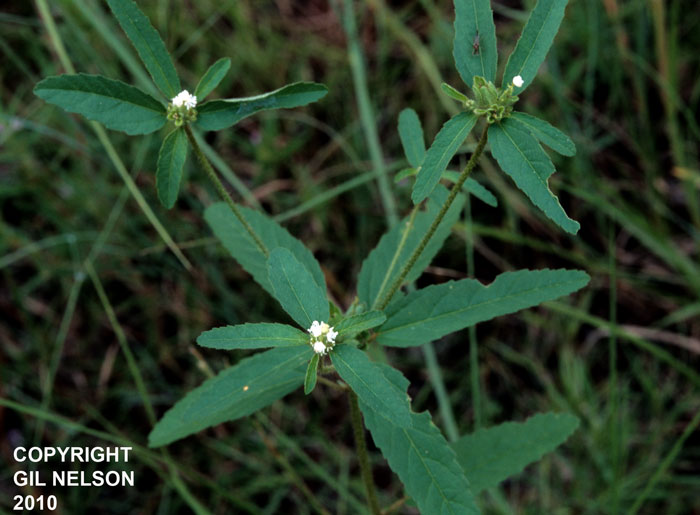Difference between revisions of "Croton glandulosus"
(→Pollination) |
|||
| Line 30: | Line 30: | ||
===Fire ecology=== <!--Fire tolerance, fire dependence, adaptive fire responses--> | ===Fire ecology=== <!--Fire tolerance, fire dependence, adaptive fire responses--> | ||
Are included in the flowering plant survery – post burn – in Heuberger’s study<ref>Heuberger, K. A. and F. E. Putz (2003). "Fire in the suburbs: ecological impacts of prescribed fire in small remnants of longleaf pine (Pinus palustris) sandhill." Restoration Ecology 11: 72-81.</ref> | Are included in the flowering plant survery – post burn – in Heuberger’s study<ref>Heuberger, K. A. and F. E. Putz (2003). "Fire in the suburbs: ecological impacts of prescribed fire in small remnants of longleaf pine (Pinus palustris) sandhill." Restoration Ecology 11: 72-81.</ref> | ||
| − | ===Pollination=== | + | ===Pollination=== |
| + | Mark Deyrup at Archbold Biological Station observed these Hymenoptera species on ''Croton glandulosus'' | ||
| + | |||
| + | Sphecidae: Cerceris blakei | ||
| + | |||
| + | Sphecidae: Philanthus ventilabris | ||
| + | |||
===Use by animals=== <!--Herbivory, granivory, insect hosting, etc.--> | ===Use by animals=== <!--Herbivory, granivory, insect hosting, etc.--> | ||
===Diseases and parasites=== | ===Diseases and parasites=== | ||
Revision as of 17:32, 26 June 2015
| Croton glandulosus | |
|---|---|

| |
| photo by Gil Nelson | |
| Scientific classification | |
| Kingdom: | Plantae |
| Division: | Magnoliophyta - Flowering plants |
| Class: | Magnoliopsida – Dicotyledons |
| Order: | Euphorbiales |
| Family: | Euphorbiaceae |
| Genus: | Croton |
| Species: | C. glandulosus |
| Binomial name | |
| Croton glandulosus L. | |

| |
| Natural range of Croton glandulosus from USDA NRCS Plants Database. | |
Contents
Description
Distribution
Ecology
Habitat
It can be found in mid-grass prairie communities.[1] It can also be found in longleaf pine communities, though it is not as common since they're dominated by perennial species.[2]
Phenology
It is seasonal; it is mainly found from May to December, peaking in September in a study at Padre Island.[1]
Seed dispersal
Seed bank and germination
It germinates after fire.[1]
Fire ecology
Are included in the flowering plant survery – post burn – in Heuberger’s study[3]
Pollination
Mark Deyrup at Archbold Biological Station observed these Hymenoptera species on Croton glandulosus
Sphecidae: Cerceris blakei
Sphecidae: Philanthus ventilabris
Use by animals
Diseases and parasites
Conservation and Management
Cultivation and restoration
Photo Gallery
References and notes
- ↑ 1.0 1.1 1.2 Lonard, R. I., F. W. Judd, et al. (2004). "Recovery of vegetation following a wildfire in a barrier island grassland, Padre Island National Seashore, Texas." Southwestern Naturalist 49: 173-188.
- ↑ Simkin, S. M., W. K. Michener, et al. (2001). "Plant response following soil disturbance in a longleaf pine ecosystem." Journal of the Torrey Botanical Society 128: 208-218.
- ↑ Heuberger, K. A. and F. E. Putz (2003). "Fire in the suburbs: ecological impacts of prescribed fire in small remnants of longleaf pine (Pinus palustris) sandhill." Restoration Ecology 11: 72-81.